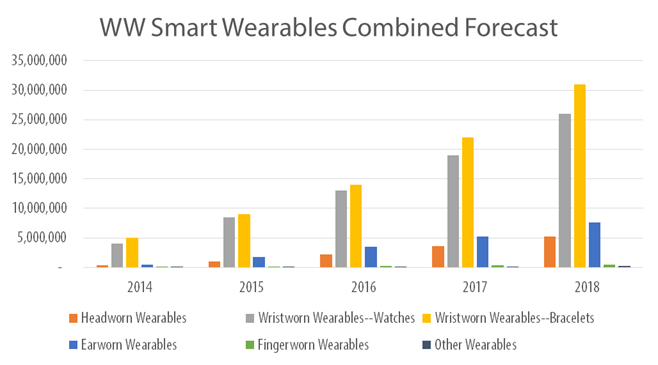|
TECHnalysis Research Blog April 1, 2014 Analyzing and discussing a product category from afar is always a fun exercise, but for me, the pedal doesn’t really hit the metal until I put together a market forecast. As an industry analyst, building forecasts is part of what I do and the process helps me crystallize my thoughts about the direction I believe a market is taking. To do it well, you need to think about definitions, categorization, key component trends, new technologies, consumer trends, big vendors, small vendors and lots more. I’ve put together many forecasts on PCs, tablets and smartphones over the years, but just recently completed the task of building my first forecast for the smart wearables market. Doing this one was a particularly interesting exercise because of the relative newness of the category and the rapid speed at which it’s evolving. Of course, it’s also a very hot topic now—witness all the recent columns that have been written here on Techpinions—so that made it fun as well. But the other reason that it was interesting is because of how wide ranging the existing forecasts are—they are truly all over the map, which simply confirms how dynamic a marketplace it currently is. In fact, because of this, I also built three different forecast scenarios with three different sets of numbers that represent where the market could go: a baseline (most likely) scenario, an optimistic scenario and a pessimistic scenario. Despite all the hype, my expectation is that the worldwide market for smart wearables (my baseline view) will be decent, but not as large as many have predicted, at least in the near term. Specifically, I’m forecasting the combined total of the wearables market—and I’ll explain exactly what I mean in just a bit—will be about 9.9 million unit shipments this year, generating just under $2.1 billion dollars in worldwide revenues. The US market will represent a large majority of worldwide shipments and revenues with 7.7 million units in 2014 and $1.7 billion in revenues. I define smart wearables as “intelligent devices that are worn somewhere on the human body and that generate and/or display and/or communicate digital information.” To be clear, that digital information may be no more than a vibrating notification that a new text message has arrived on your phone, but it is information nonetheless. In order to make sense of the market, I chose to break it up into six subcategories that are determined primarily by where on your body the device is worn: “headworn” wearables, such as smart glasses; “wristworn” wearables, broken up into two separate categories for smart watches and smart bracelets; “earworn” wearables, such as smart headsets; “fingerworn” wearables, such as smart rings; and a tiny catch-all “other wearables” category for things like necklaces, pins and other non-standard (at least at present) form factors. By 2018, the end of the five-year forecast period, my baseline forecast has worldwide wearable shipments across all six categories totaling just over 70 million units and generating approximately $12 billion in revenues. For the US, the numbers are about 14 million units and $6.2 billion in revenues. The chart below graphically depicts the worldwide shipment numbers split by category. As you can see, I expect the “wristworn” categories of smart watches and smart bracelets to be the most successful by far, with the lower-cost smart bracelets owning the largest portion of the wearables market throughout the forecast period. Of course, when it comes to wearables, there are still more questions than answers, but it’s going to be an interesting market to watch. Here's a link to the original column: http://techpinions.com/a-wearables-forecast/29032
|








